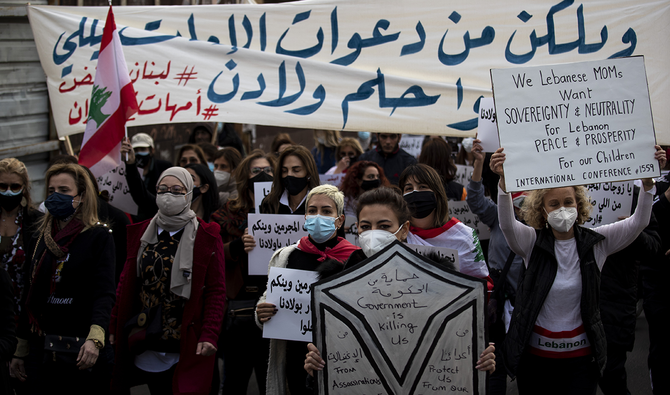
By NADIM SHEHADI — arabnews.com — Two parallel narratives about Lebanon prevail: One is about the country being a failed state and the other is about a state that has been battered until it failed. According to the first narrative, Lebanon is an artificial country created by colonial powers; it never became a proper sovereign nation, while its people are divided and have no sense of patriotism or nationalism and only care for narrow family and sectarian interests at the expense of the country as a whole. It also states that Lebanon is a failed state ruled by a corrupt sectarian elite, a kleptocratic oligarchy of former warlords and feudal families whose allegiances are to foreign powers and who have perpetuated their rule through clientelism and gerrymandered elections. The country was bankrupted by a Ponzi scheme run by an alliance of mafia-style bankers and militia leaders. This point of view maintains that Lebanon was never a viable project and its history is one of continuous conflict and external intervention, with a few cease-fires in between. Furthermore, there is no real productive and self-sufficient economy; it is a rentier economy consisting mainly of services that are totally dependent on volatile external relations, and it is thus not sustainable. Hence, Lebanon should invest in industry and agriculture, as well as modern information technology and innovation.
According to this narrative, last year’s Beirut blast was the result of corruption and negligence and the lack of movement on reforms and a recovery plan since the financial collapse of October 2019. It was caused by the selfishness and carelessness of the ruling class. The whole political establishment is thus rotten to the core and must resign en masse (“all means all”) and political parties should be abolished and replaced by competent technocrats with extraordinary powers to enact reforms and implement the policies needed to get Lebanon out of this crisis. Meanwhile, the battered state narrative declares that the country has been subjected to a systematic and coordinated “battering” since September 2004, when UN Security Council resolution 1559 challenged the Syrian presence and the arms of Hezbollah. Lebanon gradually became held hostage by Hezbollah, which effectively replaced Syria, and the ransom paid every year to keep the hostage alive has bankrupted the country.
First there was a series of assassinations, beginning with former Prime Minister Rafik Hariri, who was accused of being the behind-the-scenes architect of resolution 1559. This started in October 2004 and continues to this day, targeting journalists, politicians, the military and police officers, as well as civil society activists. It is difficult to calculate the ransom precisely. The country is kept in a continuous state of war, including the 2006 summer war with Israel that established the fact that the institutions of the state have no say in decisions of war and peace, and that these are instead the sole prerogative of Hezbollah. Adding to the damage to infrastructure and the economy are the constant and regular declarations of war, which cause immense damage to the summer tourist season, investment projects and brain drain of people leaving for lack of confidence in the country’s future. Through Hezbollah’s control over both the airport and the port and its continued paralysis of the economy, as well as its blocking of reforms, the formation of a government and parliamentary and presidential elections, it gained complete control of the country and isolated it from its main markets in the Arab Gulf and the West.
Many of these crises and assassinations were connected to developments in the Special Tribunal for Lebanon (STL). Beirut was occupied for 18 months from December 2006 in an attempt to block the government from requesting the formation of the tribunal by the UN. Similarly, in January 2011, the government was brought down by the coercion of some of its members in order to prevent the STL from issuing its indictment of Hezbollah members. The Beirut blast was also blamed on the continued paralysis of the system that has produced rot and dysfunction and on the control of the port by Hezbollah. Additionally, all these problems are related to regional developments, with a similar pattern of institutional collapse in Palestine, Lebanon, Syria, Iraq and Yemen and their replacement by militias affiliated with Iran’s Islamic Revolutionary Guard Corps. Hezbollah is the Lebanese arm that also acts on a regional scale in Syria, Yemen and Iraq, using similar instruments like assassinations, the paralysis of government and maintaining a state of war. This narrative calls for the return of Lebanon as an open and free society with an open economy and good relations with the West and the Arab Gulf states. This is what made the country successful in the past and attracted the region’s business and cultural elite. In the last 100 years, Lebanon has also succeeded in being accepted as a nation state by most of the communities that had rejected it at its foundation. Both narratives claim to be part of the same revolution, both want to implement the Taif Agreement, albeit different parts of it, and both have similar slogans, but with different meanings and emphasis.
The followers of the failed state narrative accuse those behind the battered state narrative of using Hezbollah as a scapegoat, blaming it for all the country’s problems and as a cover-up for the corruption of the system. Meanwhile, the proponents of the battered state narrative accuse the backers of the failed state narrative of self-flagellating and using this argument to cover up the crimes of Hezbollah. This could, of course, be resolved in the next election — if the country is not again blocked from holding them. • Nadim Shehadi is the executive director of the LAU Headquarters and Academic Center in New York and an Associate Fellow of Chatham House in London.



